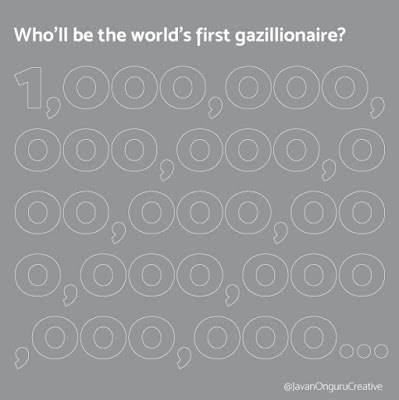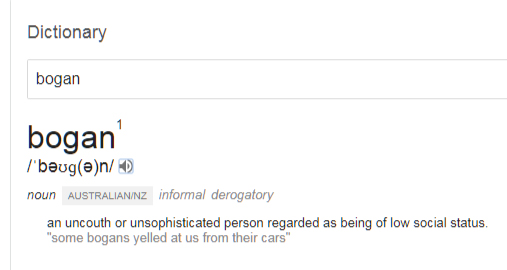We’ve all heard of millionaires and billionaires. But the world is yet to see its first trillionaire—in any currency—apart, perhaps, from Zimbabwe’s.
Now if you were to count to a trillion at the rate of one integer per second, you will require 31,710 years. And then? I’m sure you’ve heard of “zillion,” “gazillion,” “prillion,” etc., for large numbers, or even the ubiquitous “Mega-Million.” But it is fairly obvious that most people don’t know the proper names. So, where do we go from million? After a billion, of course, is trillion. Then quadrillion, quintrillion, sextillion, septillion, octillion, nonillion, and decillion:
million = 1x10⁶
billion = 1x10⁹
trillion = 1x10¹²
quadrillion = 1x10¹⁵
quintillion = 1x10¹⁸
sextillion = 1x10²¹
septillion = 1x10²⁴
octillion = 1x10²⁷
nonillion = 1x10³⁰
decillion = 1x10³³
undecillion = 1x10³⁶
duodecillion = 1x10³⁹
tredecillion = 1x10⁴²
quattuordecillion = 1x10⁴⁵
quindecillion = 1x10⁴⁸
sexdecillion = 1x10⁵¹
septemdecillion = 1x10⁵⁴
octodecillion = 1x10⁵⁷
novemdecillion = 1x10⁶⁰
vigintillion = 1x10⁶³
unvigintillion (or vigintunillion) = 1x10⁶⁶
duovigintillion (or vigintiduoillion) = 1x10⁶⁹
trevigintillion (or vigintitrillion) = 1x10⁷²
quattuorvigintillion (or vigintiquadrillion) = 1x10⁷⁵
quinvigintillion (or vigintiquintrillion) = 1x10⁷⁸
sexvigintillion (or vigintisextillion) = 1x10⁸¹
septvigintillion (or vigintiseptillion) = 1x10⁸⁴
octovigintillion (or vigintoctillion) = 1x10⁸⁷
nonvigintillion (or vigintinonillion) = 1x10⁹⁰
trigintillion = 1x10⁹³
untrigintillion = 1x10⁹⁶
duotrigintillion = 1x10⁹⁹
ten-duotrigintillion = googol = 1x10¹⁰⁰
.
.
Skewer's number = 1x10¹³⁰
.
.
centillion = 1x10³⁰³
.
.
googolplex = 1x10ᵍᵒᵒᵍᵒˡ
There are no names for the numbers between googol (defined in 1929 by American mathematician Edward Kasner and named by his nine-year-old nephew, Milton Sirotta. If it sounds familiar, it is because Google was named after this number, but they got the spelling wrong—which is probably another post for another day), Skewer’s number, centillion, and googolplex, one of the largest numbers ever named, and represented as 1 followed by googol zeros. Skewer's number is the largest number ever used in a mathematical proof. The centillion is 100 groups of 3 zeros beyond 1,000, which follows the American convention of naming numbers.
Apparently, there is no universal agreement on naming large numbers. Webster's Dictionary differentiates between American and British systems of numeration, which explains why a billion is 1,000,000,000 in the United States, while in Britain it is 1,000,000,000,000. The list above follows American convention.
And then there’s Graham's number. This number is big. Actually, Graham's number is mind-bendingly huge, bigger than the age of the Universe, whether measured in years (approximately 14 billion years) or seconds (4.343x101¹⁷ seconds. It's bigger even than Avogadro's number, a sizeable 6.02214129 x 10²³. This is the number of hydrogen atoms in 1 gram of hydrogen, also called a mole, and is the standard unit for measuring any amount of a substance in chemistry or physics. Graham's number is bigger still than the number of atoms in the observable Universe, which is thought to be between 10⁷⁸ and 10⁸². It's also bigger than the 48ᵗʰ Mersenne Prime—2⁵⁷,⁸⁸⁵,¹⁶¹-1—the biggest prime number known, with a gobsmacking 17,425,170 digits.
Graham's number is also bigger than a googolplex, which Milton initially defined as a 1, followed by writing zeroes until you get tired, but is now commonly accepted to be 10ᵍᵒᵒᵍᵒˡ. A googolplex is significantly larger than the 48ᵗʰ Mersenne Prime. You, or rather a computer, can write out the 48ᵗʰ Mersenne Prime in its entirety, all 17,425,170 digits. But no person, computer, or civilisation will ever be able to write it out in full. This is because there is not enough room in the Universe to write down all googol+1 digits of a googolplex. "You will get some idea of the size of this very large but finite number from the fact that there would not be enough room to write it if you went to the farthest star, touring all the nebulae and putting down zeros every inch of the way," said Kasner and his colleague James Newman in their 1940s book Mathematics And The Imagination, which introduced the world to these numbers.
Now, Graham's number is bigger than the googolplex. It's so big, the Universe does not contain enough stuff on which to write its digits. It's literally too big to write. But this number is finite, it's also a whole number. Despite it being so mind-bogglingly huge, what is known about it is that it is divisible by 3 and ends in a 7.
This article first appeared on my Facebook and Instagram pages. Do pass by and show some love. Or Likes!



Comments
Post a Comment